Woodpecker Deterrents
Tuesday, July 2, 2013
Woodpecker Control Solutions for Home Siding Installers
Anticipating this problem and offering your customers a solution will leave you with a grateful customer in the long run—a customer who will recommend you to their neighbors and friends. Large corporate customers will be equally grateful that you spared them the future expense of repainting and repairs.
Here are three effective woodpecker deterrents recommended by today’s bird control professionals:
BeakGuard™ Woodpecker Deterrent
This scientific breakthrough has been shown to keep woodpeckers away from siding and other painted surfaces. Known as BeakGuard, it covers virtually any latex-painted surface—including wood, fiber-cement, stucco, aluminum or vinyl. After it’s applied, the elastomeric acrylic finish communicates a warning signal to woodpeckers that says this surface is unwelcome and not worth the trouble to peck. The specially formulated compound is harmless to woodpeckers or other birds. It’s also durable and long lasting. And it resists dirt pick up. Harsh weather won’t affect it either. BeakGuard establishes a tough, vapor permeable, flexible membrane that is colorfast. Best of all, it's easily applied using a brush, roller, paint pad or conventional spray equipment. One gallon will protect about 180 square feet.
3/4” Mesh Woodpecker Netting
Developed to deny woodpeckers access to siding and other vulnerable wood surfaces, Woodpecker Netting provides a proven effective barrier deterrent that blocks woodpeckers doing any damage. The 3/4-inch mesh netting is made of durable UV-protected polypropylene, which means it will last for season after season of harsh weather. Woodpecker mesh netting is lightweight, easy to handle and install. And something your customers will like is that this netting is practically invisible, so it blends aesthetically with its surroundings. Woodpecker netting comes in 14 x 100-foot rolls and is quickly installed using Poly Clips or staples.
Woodpecker Deterrent Kits
Ideal for discouraging woodpeckers from coming around, Woodpecker Deterrent Kits come with a Bird Repeller Balloon, a 50-foot roll of Flash Tape, and all the hardware you need to easily affix them to virtually any surface. Flash Tape Banners snap and pop in the breeze and reflect sunlight, which will convince woodpeckers to move on to someone else’s house. Bird Repeller Balloons display big “predator eyes.” When the balloons bob and weave in the wind, woodpeckers get the feeling that they are being “eyeballed” for a meal and won’t want to hang around. To ensure woodpeckers don’t get used to these visual woodpecker deterrents, it’s a good idea to move them around frequently.
Friday, January 4, 2013
Woodpecker Deterrents Can Save You Money & Grief

With bird season right around the corner, the one bird you definitely want to deter is the woodpecker. While it’s interesting to watch them hammer holes in trees, it’s not so interesting when they’re turning your home siding into Swiss cheese. Or when they’re pulling the insulation out of your exterior walls to make room for nests.
The time to install woodpecker deterrents is before the birds arrive, not after. Once your siding and decorative beams are riddled with holes, you’re left with expensive replacement costs. And like a woodpecker, you’ll be beating your head against the wall for not being proactive about woodpecker control. Your neighbor may have told you that woodpeckers are looking for harmful bugs when they peck holes in your siding. But according to the experts, this is the case less than 10 percent of the time, and when they do dig for bugs, the insects are usually harmless to wood or siding.Woodpeckers are not too particular about what they peck. They’ll “ventilate” mahogany siding, plywood, beams, plastic guttering, light posts, even synthetic stucco finishes.You may be tempted to shoot the little peckers, but be warned: destroying their nests, or using poisons are cruel methods are illegal in many areas. Here are some woodpecker deterrents that are both humane and effective:Lightweight Plastic Bird NettingIdeal for physically denying specific areas of your home from woodpecker attacks, Lightweight Plastic Bird Netting has been proven to work in homes and businesses around the country. This bird netting comes in a number if mesh sizes. For woodpeckers, the 3/4-inch mesh netting is most often recommended. This netting even comes in a variety of colors to match the exterior color of the structure. Used as a woodpecker deterrent, the netting is best installed in overhanging eaves, patio covers or other elevated areas of a structure. Woodpecker Deterrent KitsPacked with everything you need to get rid of woodpeckers, Woodpecker Deterrent Kits include a Bird Repeller Balloon, 50 feet of Flash Tape, and mounting hardware. The Flash Tape Banners rattle in the breeze and reflect sunlight to constantly distract and annoy the birds. Bird Repeller Balloons are covered with large Cyclops “predator eyes” and whip about in the breeze to further distract the birds. All you have to do is move these visual deterrents around from time to make woodpeckers believe they constitute a real threat. BeakGuard Woodpecker DeterrentAn innovative development from bird control experts, BeakGuard Woodpecker Deterrent is an elastomeric acrylic finish that conveys a warning signal to woodpeckers that discourages them from pecking your wood. The compound is harmless to woodpeckers and other birds. BeakGuard covers latex-painted surfaces, wood, fiber-cement, stucco, aluminum or vinyl. It leaves a durable, color fast, vapor permeable finish that resists dirt and harsh weather. It’s easily applied with a brush, roller, paint pad or power sprayer. And one gallon covers about 180 square feet.Tuesday, December 11, 2012
Homeowners…Paint Your Way to a Woodpecker-Free House

If you’re a homeowner in any area where there are trees, you’ve probably had problems with woodpeckers. They often drill nasty, gaping holes in your siding, fascia boards, EIFS, and those beautiful architectural elements created with foam.
The problem is compounded by the fact that woodpeckers are classified as migratory, non-game birds and are protected by the Federal Migratory Bird Treaty Act. So forget about poisons or pellet guns. Lethal controls or nest destruction can only be implemented with a special permit issued by the Law Enforcement Division of the US Fish and Wildlife Service, and after recommendation of USDA-APHIS-Wildlife Service’s personnel.So what can you do to protect your home from woodpecker damage? Fortunately, there’s a humane and highly effective woodpecker deterrent that’s recently been developed. It’s Called BeakGuard.BeakGuard WorksBeakGuard is a paint-on Woodpecker Deterrent that quickly conveys a warning signal to any woodpecker that may be tempted to start pecking on your home. The results are startling and virtually immediate. After two years of field testing in the most prolific woodpecker areas of the country including Montana, Colorado, South Dakota and Washington, BeakGuard scored a success rate that exceeded 90% in deterring further building damage. BeakGuard was tested on building structures experiencing ongoing woodpecker problems. In one test, a remodeled office building outside of Seattle, Washington with large EIFS cornices (coated foam insulation) was assaulted by woodpeckers every season. Some years the drumming resulted in more than 10 holes around the building—holes that eventually became nesting sites for smaller birds. The holes had to be filled with spray foam, sanded and refinished every year. After coating the building with BeakGuard, not a single woodpecker has damaged the building. BeakGuard is Easy to Apply Easily applied to latex painted surfaces, wood, fiber-cement, stucco, aluminum or vinyl, BeakGuard is an elastomeric acrylic. You can apply it with a brush, roller, paint pad or appropriate spray equipment. One gallon covers about 180 square feet. Thinning of the product is not recommended. BeakGuard should be screened prior to spray application, and the manufacturer recommends that you don’t thin the product. Back-roll BeakGuard when applying over acrylic finishes or other textured substrates. Depending on your climate, BeakGuard usually dries in just 24 hours. BeakGuard Won’t Harm BirdsBeakGuard uses a common compound that will not harm woodpeckers or any other bird species. In fact, the ingredients in BeakGuard are used in many consumer products on the market today. Products like nail biting and thumb sucking deterrents used to break children of these habits use this technology. BeakGuard Lasts and is Color FastBeakguard is specially engineered to leave a durable, long lasting finish. It resists dirt pick up and holds up to season after season of rough weather. It leaves a vapor permeable, flexible membrane that ensures the color won’t fade or change in tone.Wednesday, November 21, 2012
Homeowners: Is Your Siding Being Ruined by Birds?

If your siding is being damaged by birds, the likely culprits are woodpeckers or swallows. Without effective bird control measures to deter them, woodpeckers will peck holes in both your wood and stucco. Smaller birds will even nest in abandoned woodpecker holes. Swallows prefer to nest on vertical surfaces under eaves or overhangs, leaving unsightly and damaging mud nests on the sides of your home.
Woodpeckers have also been known to penetrate siding and yank out the underlying wall insulation. Holes created by determined woodpeckers can be as large as 4 inches in diameter. Imagine how your home would look if you had holes that size peppered all over your siding. You’d have to replace it or risk rainwater getting into the side of your home. That’s a huge expense you don’t really need in these tough economic times. You need to be proactive if you want to protect the sides of your home from bird damage. Wood siding, window frames, eaves, trim and fascia boards are all fair game. As are rustic, channeled plywood with cedar or redwood veneers. BB guns, bird poisons, or attacking their nests are a no-no. Woodpeckers and swallows are migratory, non-game birds that are protected by the Federal Migratory Bird Treaty Act. Non-lethal, humane bird control measures should be used. Here are three effective bird control deterrents you should consider: Woodpecker Netting 3/4" MeshLightweight, easy to handle and virtually invisible, 3/4” mesh plastic bird netting will prevent woodpeckers and swallows from accessing specific areas of your home. The netting comes in 14’ x 100’ pieces, can be cut to the desired size, and is easy to store and use. The best netting will be made from UV-protected polypropylene for lasting durability outdoors. A bird netting kit makes this netting easy to install. The kits include Poly Clips to secure the netting under eaves. These self-adhering clips hold the netting tightly in place.Red-Tail Hawk DecoysEven the dumbest, most determined bird knows it’s time to leave when they see a Red Tail Hawk. Decoys of this predator make decorative bird-control accents around your home. Always get the most realistic decoy you can buy. The best hawk decoys will be manufactured of heavy duty plastic to remain convincingly realistic year after year. Just place them in high visibility areas near your home and move them around from time to time to sustain the illusion of a real live hawk.Visual Bird DeterrentsEasy to install and relatively inexpensive, Visual Bird Deterrents include Flash Tape and Reflective Banners, which whip about in the breeze and catch the sunlight. Equally effective are Scare Eye Diverters and Bird Scare Balloons, which boast mock predator eyes that glare down on birds to convince them that danger is near. Attach these deterrents to high visibility areas around the perimeter of your home, and move them around often to convince birds they are “living” threats.Tuesday, August 21, 2012
Birds Attacking Your Siding? Put Some Bird Control on Your Side.

Are woodpeckers pecking holes in your wood or stucco? Do you have so many holes in your siding that smaller birds have started to nest in abandoned woodpecker holes? Without effective and humane bird deterrents, your home will be at the mercy of woodpeckers. Can you afford the expense of re-siding your home right now?
One homeowner had woodpeckers eating through the mahogany siding covering her home. But when she filled in the holes and the house was repainted, the woodpeckers came back as soon as the painters left. One woodpecker put its head into the hole it had made and yanked insulation right out of the wall. Woodpeckers have been known to peck away at siding and tear out the insulation to make a hole suitable for nesting.
Another homeowner had woodpeckers pecking right through her wood siding and through the plywood underneath. The birds promptly tore the insulation out and built a nest between the wallboard and plywood. She put tin over the holes, but the birds just pecked a new hole next to the tin. She plans on putting vinyl siding over the wood, but believes they may peck through that as well. A consultation with a bird control expert would be a smart first move.
Contrary to common belief, woodpeckers aren’t looking for bugs when they peck holes in your siding. Experts suggest that woodpeckers seek bugs in your boards less than 10 percent of the time. And the bugs they’re looking for are usually harmless to your wood or siding.
Getting rid of woodpeckers can be a challenge—unless you use professional bird control methods. Shooting them, destroying their nests, or using poisons are cruel methods that may be illegal. Woodpeckers are protected in most states, so these methods are ill advised. Here are some woodpecker deterrents the pros recommend:
Woodpecker Deterrent Kits
To get rid of woodpeckers, get a Wood Pecker Deterrent Kit. They come with a Bird Repeller Balloon, a 50-foot roll of Flash Tape, and all the hardware you need to hang them up. Flash Tape Banners crinkle in the breeze and reflect sunlight, which will scare most birds away. Bird Repeller Balloons are covered with a big “predator eye.” The balloons bob and weave in the wind and convince birds that a giant predator is ogling them. To ensure woodpeckers don’t get used to these “threats,” your should move them around frequently.
Lightweight Plastic Bird Netting
By physically blocking out birds from your siding, Lightweight Plastic Bird Netting denies woodpeckers access to it. Bird netting comes in several mesh sizes. For woodpeckers, get 3/4-inch mesh netting. You can also get bird netting in a variety of colors to match your home's exterior. To keep woodpeckers away, install the netting in overhanging eaves or other nooks and crannies where woodpeckers peck.
Thursday, April 12, 2012
Woodpecker Netting: the Ideal Woodpecker Deterrent

by Alex A. Kecskes
If you’ve begun to see little holes and cavities in your home’s siding; if your patio cover is starting to look like Swiss cheese; and if you’re awaked in the mornings by the tat-tat-tat of bird beaks, well, you lucky homeowner, you’ve got some serious woodpecker problems.
Chances are, you’re being invaded by any of the 22 species of woodpeckers in North America. Most woodpeckers are attracted to earth-tone or natural-colored stains and paints. And whether it’s the Downey Woodpecker, the Hairy Woodpecker, Pileated Woodpecker, or the Northern Flicker, they'll come a knockin' and do their damage in one way or another.
You really can’t blame the little critters. They’re just foraging for insects under your eaves, siding and patio beams. Problem is, if you don’t implement some effective bird control, the tapping of one woodpecker will draw more birds to your home, and before you know it, you’ll have woodpeckers creating a symphony of destruction. And that means you’re in for some major repairs; something you don’t need in this bad economy.
If you’re thinking of using pellet guns, firecrackers, or bird poisons, forget it. You’ve got kids and pets to protect, and finicky neighbors who will bristle at the thought.
Time to implement a bird control strategy. And one of the most effective and humane ways to deter woodpeckers from your home, patio, or gazebo is Woodpecker Netting.
An ideal physical barrier, woodpecker netting has been specially designed by bird control experts to keep woodpeckers from pecking around your home. This netting works by denying woodpeckers access to wood or stucco siding. After a few unsuccessful tries, the birds will simply get discouraged by the barrier and move on to someone else’s home.
Woodpecker netting consists of a tight 3/4-inch mesh that’s small enough to prevent woodpeckers from getting through. The best netting is made from durable U.V.-protected polypropylene. This netting is lightweight, virtually invisible and easy to handle. It can even be stored and re-used as needed. And it comes with a one-year guarantee.
Woodpecker netting typically comes in a 14 x 100-foot roll. For fast, easy installation, it’s recommended that you get the added hardware, which includes “Poly-Clips. These clips make it easy to hang the net under eaves or other areas. When installing the netting, be sure to position it away from the wall of your home. Secure it to the outer edge of an eave or overhang using Poly Clips, staples, or other attachments. You can let the netting drape down the side of the wall and hang it using weights, or secure it back to the building with self-adhering hooks (you’ll find these at most hardware or lawn and garden centers).
One final bit of advice: If woodpeckers are starting to build nests in your siding, add a woodpecker nesting box. This will give them an alternative to drilling a hole in your siding.
Related articles
- Woodpeckers on Homes...the Damage Can be Costly (woodpecker-control-products.com)
- Got Holes in Your Patio Cover/Gazebo? You Need Bird Control for Woodpeckers (woodpecker-deterrents.com)
Wednesday, March 14, 2012
Friendly and Effective Woodpecker Control

